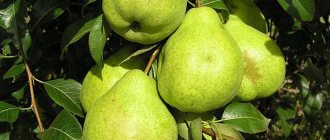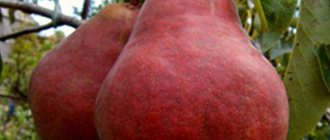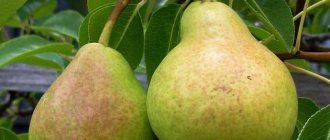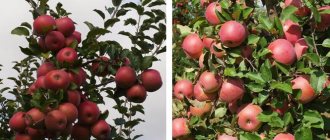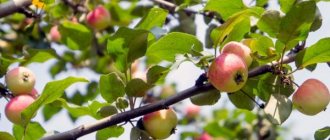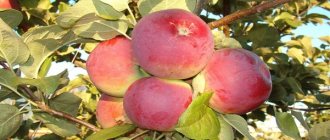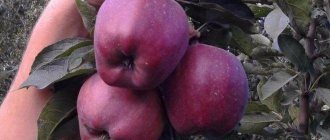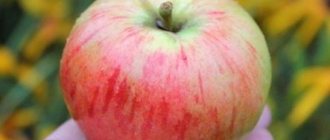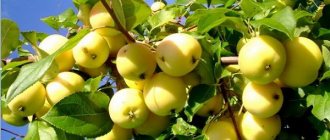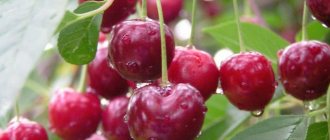History of selection and region of breeding
In the Saratov and Sverdlovsk experimental stations, this variety was obtained by pollinating “Lukashovka Polya” with a mixture of pollen from several southern varieties. Such authors as L.A. Kotov and G.V. Kondratyeva were involved in the breeding of Sverdlovsk.
Climatic conditions
The Sverdlovsk autumn pear is highly resistant to frost.
What type of pear is it?
Sverdlovsk is an autumn and summer pear variety, depending on the growing region. The variety is winter-hardy, highly frost-resistant. According to their intended purpose, the fruits are considered dessert.
Description of Sverdlovsk pear
Most often grown for export, as the fruits ripen in early autumn. Fruiting is abundant and regular.
Other features of the tree include:
- Compact crown of medium density and round shape. The bark of the central branches is greenish-gray in color;
- Fruits appear on ringlets at the age of two years;
- The leaves are dark green, glossy, ovate, sometimes elliptical in shape. The cuttings are elongated, with saber-shaped growths;
- The flowers are white, small in size, and shaped like a bowl. Color appears late;
- The variety is self-sterile and will not bear fruit without pollination by foreign varieties. That is why it is worth selecting a pollinator for the Sverdlovsk pear in advance;
- The fruits are large, on average reaching from 130 g to 140 g;
- The shape of the fruit is elongated pear-shaped, sometimes short. The surface is smooth; when ripe, the color changes to yellow with a slight blush. The stalks are elongated, green, and hold the fruit, protecting it from prematurely falling to the ground. This is important for preserving the presentation of the fruit;
- The pulp of the fruit is distinguished by a yellowish tint, rare inclusions of stony cells, a sweet and sour taste and a pronounced pleasant smell;
- The first harvest can be harvested already in the third year after planting;
- It is highly frost-resistant and can withstand temperature drops down to -38? C.
In the conditions of the Urals and more northern regions of the country, the fruits will ripen a little later. Harvesting here can begin in the middle or end of October.
To increase frost resistance, grow Sverdlovsk plant on a winter-hardy standard: Ussuri pear or hybrids.
The main features of the fruit include: pleasant taste, compactness of the tree, high fruiting rates. Recommended for use in the Urals and northern regions.
What the tree and fruits of Sverdlovsk look like
- The tree is medium-sized (up to 8 meters), with a compact, not very thick crown. The bark of the trunk and basic (skeletal) branches is dark gray, slightly greenish. Young branches stretch upward. The fruits are set on two-year-old shoots.
- The leaves are on long petioles, bright green, shiny, oval. The edges of the leaf blades are slightly jagged.
- The flowers are medium-sized, cup-shaped, white. The anthers are located at the same level as the pistils. Flowers bloom late.
- The fruits are round, regular pear-shaped. The average weight is about 150 g. When ripe, they remain green - however, a blush appears on the barrel on the sunny side, and the stronger the sun in your region, the more noticeable it is (but it may not be there at all). They have a strong aroma, a lot of juice, but there is almost no “graininess” characteristic of a pear when bitten. The sweet pulp has an oily texture.
This variety is early-fruiting - the tree will bloom and delight with the first pears already in 3-4 years of life. After ripening, the fruits will not fall off, but will hang on the branches. One adult Sverdlovsk can ripen up to 30 kg of pears.
Depending on the region, the fruits ripen in different ways: in the south in August, in the north - until October. In the case of cold regions, fruits that are still hard are removed from the tree, which will ripen during storage.
The fruits of this variety are suitable for various culinary purposes. Sverdlovsk woman goes: for baking (pies, pies), for drying, compotes, smoothies, juices, even wine. Well, of course, it’s just good fresh.
Tree
The crop is a tree with an average growth rate, low density, up to 8 m in height. Pear shoots grow upward and have a greenish-gray color.
The crown has a wide pyramidal shape. The leaves have a classic shape for all pears, dark green in color, with a smooth, shiny surface.
During the flowering period, small, white, cup-shaped flowers are formed on the crop, which later form fruits. The tree is distinguished by early fruiting; the first fruits can be harvested 3-4 years after planting the planting material.
Bark
The main branches, covered with dark, greenish-gray bark, reach their tips towards the sky. Fruiting occurs on numerous ringlets (starting from two-year-old wood) and on last year's growths. The shoots are not faceted, straight, greenish-brown.
Leaves
The leaves are smooth and shiny, dark green, elliptical or ovoid in shape. Finely serrated serration is barely noticeable on the edges. The leaf blade is flat or slightly folded. The petioles are long. Stipules are small, saber-shaped.
Fruit
The fruits of “Sverdlovchanka” are pears of a fairly large size, elongated pear-shaped, weighing 120-180 g. The peel of ripe fruits has a greenish-yellow color, and a slight blush may appear when exposed to sunlight.
Description of the Sverdlovchanka variety
Let's consider the Sverdlovchanka pear variety, a description of the external characteristics of the tree and fruit.
Tree
Tree growth does not exceed average . The crown is not very thick; it is distinguished by its compactness and pyramidal-rounded shape . The color of the bark and skeletal branches is dark gray with a greenish tint. The main branches stretch upward and it is on their two-year growth that fruiting is concentrated.
There are no edges on the brown-green shoots. The leaves are shiny, rich green in color, their shape is oval-ovate. The leaf blade is quite flat, its edges are jagged. Long petioles and small saber-shaped stipules.
The flowers are white, medium in size, cup-shaped. The anthers are located at the same level as the pistils. This variety blooms late.
The fruits are smooth, regular rounded pear-shaped. The weight of the fruit is average, ranging from 130 g to 180 g. Fully ripe pears are green in color, with a slight blush, which appears on the sunny side of the fruit. But in the bulk the integumentary coloring is not present at all.
The subcutaneous points are well defined and are also colored green. The seed chambers are closed, the saucer is shallow and wide, the heart is broad-hearted.
The Sverdlovchanka pear variety received its dessert purpose due to the sweet and delicate taste of the pulp, with a high juice content. The fruit has a strong aroma, the pulp has an oily structure, practically without granules.
The following pear varieties boast excellent taste: Rogneda, Karataevskaya, Pamyati Zhegalova, Yanvarskaya and Krasulya.
Chemical composition of the Sverdlovchanka pear variety:
Characteristics
The developed variety has good frost resistance and can withstand temperatures down to -38 °C without damage.
But given the conditions of the Middle Urals, especially in its northern part, these indicators are considered average. Here it would be wiser to graft Sverdlovsk on a winter-hardy rootstock.
Fruit ripening begins in August in warm areas and can last until October if the growing region is northern. If the ripeness of the fruit occurs in the summer, then the pears do not lose their presentation and do not fall off for a very long time. Fruits picked in October often ripen during storage.
Sverdlovsk plant is not capable of self-pollinating. To set fruit on the site, it is recommended to plant other pear varieties with different flowering periods. The young tree begins to bear fruit early, already 3–4 years after grafting. The annual yield increase is rapidly increasing.
The tree bears fruit abundantly and regularly, the yield is more than 200 c/ha.
Bloom
The Sverdlovsk autumn pear blooms in the middle period. During this period, white, cup-shaped, medium-sized flowers bloom on its branches. The stigmas of the pistils are at the same level as the anthers.
Self-fertility
Please note that the Sverdlovchanka variety is self-sterile! This means that in order to bear fruit, it needs a pollinating pear growing quite close.
Fruit ripening period:
Aug. Sept
Pros and cons of the Sverdlovchanka pear variety
The technical qualities of the described variety have long been appreciated by domestic gardeners.
- Pear is characterized by a large number of significant advantages, among which are:
- frost resistance of the crop, the ability to tolerate low temperatures down to –38 ° C;
- high commercial quality of fruits;
- pleasant taste of the fruits, their excellent keeping quality and transportability;
- compactness of the tree;
- precociousness;
- not high requirements for care and cultivation.
Did you know? Pear pulp is an excellent natural source of hormones of happiness and joy - endorphins. That is why juicy and aromatic fruits are recommended to be consumed for depression, nervous excitement, and stress.
Among the disadvantages of the variety, the most significant are:
- the need for pollinators, since the pear is self-sterile;
- soil quality requirements.
Characteristics of the variety
The main advantage of the variety is its large fruits. Thanks to their durable peel, they are easy to transport or store at room temperature for up to 2 weeks.
The disadvantages of the Sverdlovchanka variety include rather weak resistance to frost in the northern regions. Withstands frosts down to -30 °C. Another drawback is the lack of integumentary coloring of the fruit.
The Sverdlovchanka pear variety is unpretentious in care.
Description of the tree
The trees are low - up to 8 m. They are distinguished by a large pyramidal crown. The branches of the tree are raised upward and have a greenish-gray color.
The leaves are oval-ovate, rich green in color. They are distinguished by long petioles.
The tree is early-bearing and begins to bear fruit already 3-4 years after planting. Has a fairly high yield. From one tree you can collect up to 30 kg of pears.
When ripe, the fruits do not fall off and adhere tightly to the branches. Due to the strength of its skin, the fruits are easily transported and can be stored at room temperature for up to 2 weeks.
Description of fruits
The fruits are small in size, weight - 130 to 180 g.
During the period of initial ripeness, the fruits have a pure green color, and during full ripening they begin to turn slightly yellow. If the fruit is located on the sunny side, a slight blush may appear on it.
Appearance of fruits
Description of fruits:
- subcutaneous points are clearly defined and have a green color;
- stalks are long;
- the saucer is wide;
- the taste is sweet and sour.
This variety is classified as dessert. The type is white-yellow. The pear is thin, tender, slightly oily, juicy and aromatic.
The fruits can be used to make desserts or baked goods. They can be consumed fresh or dried. Delicious smoothies or juices are made from pears. It also makes excellent wine.
Selection of seedlings and planting technology
A high-quality, healthy and strong seedling is the key to successful further growth and fruiting of a pear. That is why the choice of planting material should be taken as seriously as possible.
Signs of a healthy seedling are:
- strong, elastic, strong root processes, without signs of rot, dryness, damage or disease;
- smooth, elastic, uniformly colored bark, without dryness, roughness or wrinkles. The wood under the bark should have a fresh, green tint.
In the southern and central regions, the seedling can be planted in late August - early September, so that before the onset of cold weather, it can take root and take root well. In the northern regions, planting activities are recommended to be carried out in the spring, when the earth has warmed up a little.
For planting, you need to choose a young seedling, up to two years old, since an older plant will take root poorly and bear fruit much later. The pear prefers the most spacious, bright and warm place, which is well protected from drafts and cold winds, which have a negative impact on the development of the tree.
The main part of the root shoots of the crop is located at a depth of 20 to 100 cm, which is why you should choose an area with underwater water no closer than 2 m.
For planting the plant, sandy-clay or loamy soil with a neutral acidity level is considered the best option; chernozem is ideal. The planting site should be prepared in advance, presumably one to two weeks before planting the crop.
To do this, dig a hole 70-75 cm deep and 100 cm wide. The size of the hole should be such that the entire root system of the pear can freely fit into it.
Planting a seedling is carried out according to the traditional algorithm:
- part of the soil removed from the pit is mixed with 3 buckets of humus, one bucket of sand, 250 g of superphosphate and 25-30 g of potassium;
- the bottom of the seat is lined with a drainage layer of expanded clay, pebbles or broken bricks;
- a little nutrient soil mixture is poured on top of the drainage layer, from which a mound is made;
- a wooden peg is inserted into the earthen mound, which will serve as a support for the seedling;
- place the plant on the ground, carefully straighten the root shoots;
- the seedling is sprinkled with soil so that the root collar is 6-8 cm above the surface;
- the ground around the tree trunk is lightly compacted and watered generously with two buckets of settled, not cold water;
- the soil around the plant is mulched, the seedling is tied to a peg.
In the first year of development, the planted seedling should be given the highest quality and competent care, because the further fruiting of the tree will depend on this.
How to plant a pear
Tree planting occurs in the spring and autumn periods of the year. In the northern regions, it is recommended to produce it in the fall so that the roots have time to take root in the cold soil.
Before planting, you need to carefully inspect the seedling. Check to see if there are any rotten roots or branches on it. The spoiled ones should be removed immediately, leaving only the good ones.
Chernozem or sandy-clay soil is suitable for seedlings. The landing site is prepared in advance, about a week in advance. A hole is dug, the depth of which is 60-70 cm and the width is 1 m.
Planting pears on your own plot
- Sanitary inspection of seedlings. Remove all problematic, suspicious or damaged branches and roots. You can also cut off all excess (say, if the crown seems too thick to you).
- Priming. The Sverdlovsk woman likes sandy-calcareous loams. But fatty black soil, on the contrary, is harmful to it.
- Place. Choose an open, sunny area - for a good growing season, Sverdlovsk needs a lot of light.
- Pit. It is prepared 5-7 days before planting the seedling, digging 70 cm deep and 1 m wide. During planting, the soil in the hole is fluffed up and a stake is driven into the center. Now place some fertilizer-enriched soil on top of the stake. Place the seedling on a stake with its root system, distribute the roots over the hole. Fill and compact the hole slightly.
- Deepening the root collar. It should be placed 5-7 cm from the earth's surface, but not lower.
- Planting time. Nurseries say that Sverdlovsk can be planted in autumn and spring. True, if you live in the north, when planting in autumn, the roots may not have time to take root before the cold weather, so buy Sverdlovchanka seedlings only in the spring.
- Neighbours. Since this pear does not self-pollinate, plant several more pears of other varieties in the garden to set fruit. It will be better if they have different flowering times.
Immediately after planting, water the seedling with 2 buckets of water and mulch the tree trunk area (even humus will do).
In the first month, the tree will actively take root. Help it with frequent watering. To ensure that all the water goes where it is needed, you can make a shallow ditch around the seedling.
Further care of the plant after planting
Caring for a pear tree involves carrying out standard measures - watering, fertilizing, pruning, and preventive treatment. However, agrotechnical measures must be carried out regularly and in a timely manner.
Growing conditions
Pear trees of the “Sverdlovchanka” variety are relatively unpretentious, and under conditions of high agricultural technology they can significantly increase productivity. When choosing a site for planting these plants, preference should be given to loamy or sandy loam soils. Turf soil, lightly podzolic or medium podzolic soils are excellent for cultivating this variety.
The most illuminated and well-warmed by the sun places, protected from gusty and cold winds, should be allocated for pear trees. The plant is most demanding of light during the periods of flowering and fruit formation. It is advisable to place pear plantings on southern, southwestern or southeastern slopes. The bulk of the pear root system is located at a depth of 20 cm to 1 m, and the vertically directed roots of the plant reach a depth of 5 m. That is why, when choosing a site for planting, you should pay attention to the depth of groundwater.
The main care of fruit trees consists of proper crown formation, watering, fertilizing, as well as disease and pest control. Watering should be quite rare, but deep, with moisture penetrating into the soil to a depth of at least 70 cm. Regardless of the age of the fruit tree, in the spring, about 30-40 g of ammonium nitrate or urea should be applied per square meter of planting. During autumn digging, it is recommended to add 55 g of superphosphate, 20-23 g of potassium sulfate and a couple of kilograms of humus per square meter.
Fertilizing, watering
Until the plant takes root, it must be moistened regularly, 2-3 times a week. It is especially important to organize high-quality watering during pear flowering, during the fruit formation phase and after harvesting. To carry out irrigation activities, experts advise making a small ditch around the tree and pouring water into it.
As soon as the moisture is absorbed into the soil, the depression should be covered with soil. The norm for watering one tree is 2-3 buckets. It is very important to maintain a moisture balance when watering, since both excessive drought and stagnation of water in the soil have a detrimental effect on the condition of the root system and the development of the plant itself.
After moistening, the soil around the trunk must be well loosened and mulched with hay or sawdust. Such measures will prevent the development of weeds, enrich the soil with nutrients and oxygen, and also retain moisture for a long time.
Types and features of fertilizing for pears Experts recommend combining soil moisture with fertilizing of the crop, which is carried out 3-4 times during the season:
- in the spring, when the snow melts, the pear is fed with organic fertilizers, for example, humus, manure or compost;
- during the period of intensive growing season, nitrogen-containing agents are applied under the plant, which activates the growth of green mass;
- In the flowering and fruit set phase, the crop is fed with a solution of chicken droppings or liquid manure.
It is recommended to carry out the last fertilizing after harvesting. A few weeks before the expected cold weather, the soil is fertilized with products based on phosphorus and potassium.
Top dressing
The seedling must be fertilized regularly. Basically, fertilizing is carried out in the 2nd year after planting in the autumn. It is also recommended to fertilize the tree throughout the summer.
Procedure for feeding:
- Fertilizers are placed in small trenches. They are made during tree planting.
- It is best to use peat or humus fertilizer. It is mixed with earth.
- The resulting mixture is distributed along the entire perimeter of the trench.
For fertile soils, a mixture of organic and mineral fertilizers should be used. A combination of 6 kg of compost, 55 g of superphosphate, 25 g of potassium salt gives an excellent result. This is enough for 1 m2.
It is recommended to fertilize depleted soils with humus and superphosphate. Additional components – sand, potassium. Apply the mixture into 1 planting hole.
Trimming
“Sverdlovsk”, although it is a tree with medium density, however, needs annual pruning and crown formation. Branches should be pruned in early spring, before the plant enters the growing season, or in autumn at a temperature of 0…–5 °C. Activities should be carried out using a sharp, disinfected knife or pruning shears.
It is recommended to prune a two-year-old seedling at a height of half a meter from the base. Thus, the main trunk is shortened by a quarter. Every year you should thin out the branches that thicken the tree, thereby reducing its yield. Pruning should be done to the very base of the branches, without leaving stumps.
Also, every year experts advise doing sanitary pruning, removing dry, damaged, weak or diseased branches. After the procedure, all cut areas should be treated with crushed charcoal or garden pitch.
Preparing for cold weather
When cultivating pears in the southern and central regions, there is no need to prepare the tree for cold weather in a special way. It is still recommended to insulate young plants before wintering by wrapping the trunk with “breathable” natural material, for example, burlap or store-bought insulation.
When growing a crop in the northern regions, it is necessary not only to protect the trunk, but also after snow falls, to form a snow mound around the plant, at least one meter high.
Did you know? In folk medicine, not only pear fruits, but also leaves are widely used. The greens of the plant contain unique substances that have an antifungal effect. That is why decoctions from the leaves are excellent for dermatitis, fungal infections of the skin, and eczema.
Pest and disease control methods
The Sverdlovchanka variety shows excellent resistance to many ailments, in particular scab, rust and fire blight. However, in rare cases, if agricultural standards are violated, it may be susceptible to powdery mildew and sooty fungus. To treat the latter, the pear is sprayed with a soap solution and then with tobacco. In the case of powdery mildew, damaged branches and foliage are removed and burned.
To prevent the appearance of pests or the development of diseases, experts advise following some simple rules of prevention:
- do not allow excessive moisture to the tree;
- always keep the tree trunk clean, clear the soil of weeds, mulch and loosen it;
- collect fallen fruits in time, as they are a good breeding ground for fruit rot;
- carry out preventive spraying of the crop with insecticidal and fungicidal preparations.
Like other varieties of pears, “Sverdlovchanka” can also become a “victim” of spider mites , scale insects or aphids .
In order to prevent the development of the problem, it is necessary to regularly inspect the plant for the presence of parasites, and also spray it with broad-spectrum insecticides.
Causes of fruit drop
When growing pears, not only beginners, but also experienced gardeners may encounter the problem of fruit drop. The amount of so-called carrion can be large, which greatly reduces marketable yield.
Significant pre-harvest fall of pear fruits is observed when the weather is too hot and dry, which is typical for August in most regions where this plant is cultivated. Most often, the fall caused by drought occurs a month before the start of harvesting. This feature is due to the formation of a kind of cork-separating layer at the stalk, which appears due to a lack of moisture and essential nutrients. Particularly severe fruit drop is observed when the plant is overloaded with crops. The reason for fruit falling can also be prolonged stagnation of water under pear trees or damage to the plant by septoria.
The risk of fruit falling can be reduced by timely watering the tree, as well as by applying a small dose of mineral fertilizers. Spraying the plant with KANU has good results. The spraying procedure can be combined with foliar feeding of fruit trees with urea or Kristallin, diluted in a ratio of 50 g per 10 liters of water.
Advice from experienced gardeners for beginners
Often, beginning gardeners may have difficulties growing and caring for pears.
To minimize the likelihood of such problems occurring, experienced gardeners recommend following a few simple tips:
- when watering, it is better to “underwater” the plant rather than overwater it, since stagnation of water in the soil can provoke rotting of the root system, which will entail the death of the entire crop;
- if there is a lot of fruit falling, it is advised to set up watering schemes for the pear and add a small dose of mineral fertilizers to the soil, which can strengthen the tree;
- It is necessary to remove pears in dry, warm weather. Fruits collected in the morning, evening or during times of high humidity are poorly preserved;
- For long-term preservation, fruits should be stored in wooden or plastic boxes in several layers, each layer covered with sawdust or straw. The optimal conditions for storing fruit are considered to be a temperature of 0...+3 ° C and a relative humidity of 80-85%.
The Sverdlovchanka pear has a number of key advantages, thanks to which it is loved by many domestic gardeners. It is distinguished by its stable and strong immunity, rarely succumbs to diseases and pest attacks, bears fruit well, does not require special growing conditions, and is quite simple and unpretentious to care for.
Diseases and pests
The tree is resistant to diseases, parasites and pests.
For prevention, you need to do the following:
- Clear the tree trunk circle of weeds, because some may contain parasites.
- Loosen the soil frequently. You need to dig up the soil around the tree once a week after watering. This will help enrich the soil with oxygen.
- Fertilize. By feeding, the gardener helps the tree to be more resistant to pests and diseases. Properly selected fertilizer can improve the condition of the soil.
- Remove foliage from the tree trunk. The goal is to prevent weeds and parasites from appearing in them.
The description of the variety says that due to improper care, the tree can be affected by powdery mildew or sooty fungus. To remove them, you need to treat the tree first with a soap solution, and then with tobacco. In the case of powdery mildew, damaged branches and leaves should be removed immediately and then burned. This will help prevent the disease from spreading to other seedlings.
Is this pear sick?
Sverdlovsk is a variety resistant to many diseases. If you properly care for your wood, you won’t have to deal with problems such as bacterial burn, rust or scab at all.
What is proper sanitary care?
- Removing weeds near the trunk. Also, do not allow fallen leaves or rotten matter to linger here for a long time. Result: fewer parasites and viruses multiply near the roots.
- Frequent digging of the soil under the trunk. It should be carried out at least in the spring, after whitewashing, and, as mentioned above, after watering.
- The application of mineral fertilizers not only feeds the tree itself, but also makes the soil “inconvenient” for many pathogens and pests to inhabit.
- Fungicides, pesticides and insecticides are assistants not only for large farms, but also for private gardeners. The main thing is to carefully measure the amount of the drug you use. An overdose will hit both the pear and yourself.
And an experienced gardener will tell you why the leaves on a pear can turn black:
Let's summarize
- Sverdlovchanka is a variety that can be grown in the northern regions.
- Sandy-limestone loam and the sunny side of the site are suitable for seedlings. It is important that there are other pears growing in the garden or yard - they are needed for cross-pollination of this crop.
- This pear is unpretentious in care: it does not require frequent watering (three times a year will be enough), and if it grows well, it does not need to be fed. But don’t give up on pruning - in the south and in the center you can do it in spring and summer (when there are no leaves on the tree), in the north - only in spring.
And a gardener from Belarus will tell you about other winter-hardy varieties of pears for the garden:
Reviews of Sverdlovchanka pear
The Sverdlovsk pear produces fruits with a very good presentation, which, under favorable weather conditions, are firmly held on the branches and are transportable. The variety is self-sterile, but pollinates very well with other pear varieties.
Experienced gardeners note that in overripe fruits, the pulp around the seed chamber becomes very dark. However, most gardeners are very pleased with this variety and leave extremely positive reviews about it. The fruits are highly valued - oily, juicy, melting, sweet with a slight sourness, attractive in appearance and in demand on the market.
Sources
- https://selo.guru/sadovodstvo/grushi/sorta-g/letnie-g/sverdlovchanka.html
- https://DachaDacha.com/rasteniya/plodovyj-sad/grusha-osennyaya/sverdlovchanka
- https://OgorodSadovod.com/entry/3517-grusha-sverdlovchanka-osobennosti-sorta-sekrety-posadki-i-pravilnogo-ukhoda
- https://sornyakov.net/trees/grusha-sverdlovchanka.html
- https://KinzaRostov.ru/frukty/grusha-sverdlovchanka-2.html
- https://DSad12.ru/frukty/grusha-sverdlovchanka-opisanie-sorta-foto-otzyvy.html
- https://the-sad.ru/grusha/grusha-sverdlovchanka-opisanie-posadka-i-uhod-foto
- https://DachaDecor.ru/derevya/technologiya-viraschivaniya-grushi-sorta-sverdlovchanka
- https://FermoVed.ru/grusha/sverdlovchanka-opisanie-sorta.html
- https://gryadochkin.ru/osobennosti-vyrashhivaniya-desertnoj-grushi-sverdlovchanka.html
- https://fermer.blog/bok/sad/plodovye-derevya/grusha/sorta-grush/osennie-sorta-grush/5696-grusha-sverdlovchanka.html
- https://sortoved.ru/grusha/sort-grushi-sverdlovchanka.html
- https://ogorodnash.ru/grusha-sverdlovchanka/
- https://7ogorod.ru/plodovye-derevya/grusa-sverdlovcanka.html
[collapse]
